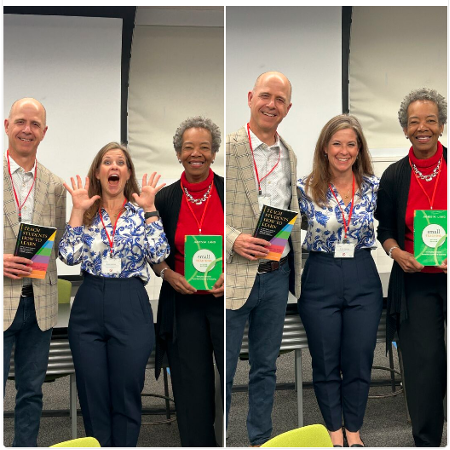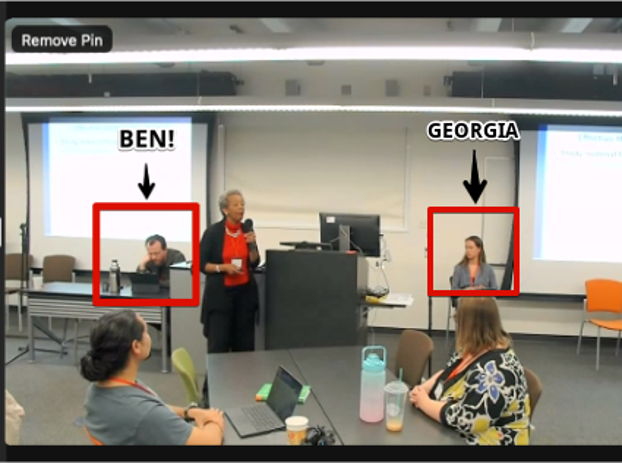Countdown to Blast-Off!
10 – Weeks of professional learning
9 – Thousand hours of dedication by LRC Director, Brook Masters
8 – Months of planning
7 – Embedded Peer Educators
6 – Academic Programs
5 – CSU Campuses
4 – TLi Team Members
3 – Incredible Sponsors
2- Dynamic Keynotes
1 – EPEC Launch Day into Summer Learning!
On June 2, 2023, CSUCI launched an EPEC Summer of Learning! With a video welcome from President Yao, an in-person welcome from Provost Avila, and one incredible panel of CSUCI Peer Tutors (students), 18 CSUCI faculty, and 10 faculty and learning center professionals from four other CSU campuses, including Cal State LA, CSU Chico, Sacramento State, and Sonoma State, gathered to kick-off the EPEC Summer Institute; a 10-week hyflex professional learning experience situated in a community of practice (Lave & Wenger, 1991) dedicated to STEM student success. EPEC is specifically focused on supporting the academic success of 1st and 2nd-year students in general STEM and English Composition “gateway” courses that have had historically high drop, withdrawal, and failure rates (DFW). Having to repeat these courses has an increased negative impact on Pell-eligible students, with many stopping out (dropping out) if failing to complete one or two courses in their first year of college (Yang & Mao, 2021).
Teaching and Learning Innovations (TLi), in partnership with Brook Masters, Director of California State University Channel Islands (CSUCI) Learning Resource Center (LRC) and Academic Success Services, supported the launch of this collective group of professional educators to support their mission to develop instructional and learning center plans to integrate embedded peer educators (student tutors) known as EPEs, into their classroom instruction and student support network in their respective courses and campuses.
Over the Moon & Reaching the Scholarly Stars

We were over the moon to be amongst the stars, with in-person keynotes from none other than Dr. James Lang and Dr. Saundra Yancy McGuire, whose books make up the core curriculum underpinning EPEC, specifically Lang’s Small Teaching: Everyday Lessons from The Science of Learning and McGuire’s Teach Students How to Learn. Each delivered EPEC moments of practical “small instructional moves” that educators can make to have a huge impact on student success.
Dr. Lang is an esteemed former English Professor and was Director of the D’Amour Center for Teaching Excellence at Assumption University, and is now a full-time speaker and author of six books on teaching and learning in Higher Education and a monthly article for The Chronicle of Higher Education. Dr. McGuire is the Director Emerita of the Center for Academic Success and retired Assistant Vice Chancellor and Professor of Chemistry at Louisiana State University (LSU). CSUCI was fortunate to have Dr. McGuire reprise her 2022 role as an EPEC featured keynote.
What is an EPE?
An Embedded Peer Educator (EPE) is an umbrella term that refers to a peer educator (student) who has been successful in a particular course previously (e.g., General Chemistry) who is then placed back into the same course as a tutor, working under the instructor’s guidance to support student success. Unique to CSUCI, and thanks to Brook’s innovative take on this model, EPEs at CSUCI are trained in coaching and learning strategies, including metacognitive techniques informed by learning science. They are continually engaged in learning about learning throughout their time as an EPE. They are prepared to work with students both during class, outside of class, and in-person or virtually between class sessions.
How does EPEC work?
EPEC is meant to give faculty and Learning Center Leaders time to make a customized plan for ways they can integrate an EPE into their instructional context, prior to the beginning of the next academic year. The Institute begins with a multimodal launch day, with options to attend in-person, virtually via Zoom, or asynchronously via Canvas and Playposit.
From June through August, this community convenes fully online, completing five asynchronous modules in Canvas with opportunities to connect synchronously through Zoom office hours and special virtual sessions hosted by Brook, TLi learning designers, featured keynote experts, and Pro-EPE Tutors. Participants also engage with this diverse CoP in asynchronous discussion forums.
Throughout EPEC, participants complete five reflective milestone tasks through which they develop an EPE integration plan, update their syllabus, and create space in the course Learning Management System (LMS) for EPEs to self-introduce and interact with students. The program culminates with two virtual half days where faculty meet with their EPE and begin to plan for an EPEC academic term. For more, feel free to explore the EPEC syllabus.
The Mission Crew
EPEC is the result of a diverse collective of dedicated efforts from community and institutional leaders, Learning Center and TLi Staff, Faculty, and of course, EPEs. The EPE model and EPEC Institute are made possible by a generous gift from the Jeff Green Family Foundation and the continued support of President Richard Yao and Provost Mitch Avila. This summer, OneHE has graciously sponsored participants, providing 3-month subscriptions since their courses are part of the EPEC curriculum.
CSUCI’s LRC Director, Brook Masters, leading her LRC staff, and several experienced EPEs continue to make this unique network of support available to students and faculty. Brook is the reason EPEs exist at CSUCI, and it is her innovative thinking and unflagging commitment to students that has brought this model to life. She will continue to be active throughout EPEC, interacting in the asynchronous discussions and hosting synchronous office hours and consults. EPEs will also hold office hours and are providing asynchronous opportunities to share examples and answer questions throughout EPEC.
TLi powers the institute’s digital and technological-pedagogical (Mishra & Koehler, 2006) side. TLi learning designers, Megan Eberhardt-Alstot and Georgia Van Tyne, are responsible for designing, developing, and co-facilitating the online institute in Canvas. We do want to give a huge shoutout to Dr. Jaime Hannans, now Associate Dean of Extended University, who partnered with Megan to design and lead the online side of the institute during EPEC’s inaugural Summer 2022 pilot. Making Launch day work required the unmatched expertise of TLi Media Lead, Ben Hytrek, making the hyflex day seamless for those in-person and virtual, and TLi Accessibility and Inclusive Design Lead, Kristi O’Neil-Gonzalez who managed small “fires” behind the technical scenes to ensure the day went off without a hitch or glitch.

Last but certainly not least are the EPE’s themselves! A special panel featured current experienced EPEs who provided insight into how they are uniquely trained to collaborate with the faculty they are supporting and the students they tutor, sharing examples of ways they can work with students in and outside of class, both in-person and online. Given their unique role and relationship with students, they also had excellent insight into students’ academic and non-academic needs. They are important educators, and we are thrilled to have them participating in EPEC this Summer!
Orbiting
So here we are – a community in practice, connected through a digital learning landscape. Educators of many different backgrounds, expertise, and knowledge with direct and indirect interactions with students. But one thing is for sure. Collectively, this EPEC community shares one heart and one purpose: ensuring all students within our spheres of influence feel connected, supported, and truly cared for. In the end, our EPEC mission’s success can only be measured if that care results in the academic and non-academic success of our students, now, next term, and “to infinity and beyond” (Buzz Lightyear, 1995).
References
Lave, J., & Wenger, E. (1991). Situated learning: Legitimate peripheral participation. Cambridge University Press.
Lightyear, B. (1995). Toy story. Disney & Pixar Press.
Mishra, P. & Koehler, M. J. (2006). Technological pedagogical content knowledge: A framework for teacher knowledge. Teacher College Record, 108(6), 1017-1054.
Yang, F., & Mao, Y. (2021). Which Factors Impact Pell Grant Students’ Persistence and Graduation? Journal of Higher Education Theory and Practice, 21(3), 111–122. https://doi.org/10.33423/jhetp.v21i3.4148